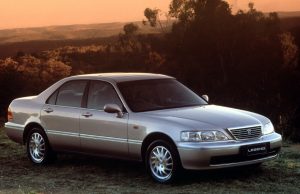Recalls: Honda KA9 Legend
Overview
Manufacturers, or importers, issue recalls for defects or faults which have the potential to cause injury. Generally, manufacturers will inform the original buyers if their vehicle is subject to a recall and of the steps required to remedy the defect or fault. Please note that the recalls below (if any) are for Australian-delivered vehicles only. Furthermore, the number of recalls should not be taken as an indication of a model’s reliability or its safety more generally.
Recalls: Honda KA9 Legend
1996-98 Honda KA9 Legend: front ball joints and steering failure
In May 1999, a recall was issued for 1996-98 Honda KA9 Legend models due to potential steering failure. This could be caused by the front suspension lower ball joints separating due to wear of the polyacetal plastic seats and ball pins (PRA 1999/3941).
1996-99 Honda KA9 Legend: loss of drive without warning
In August 1999, a recall was issued for 1996-99 Honda KA9 Legend models due to the sealing bolt of the automatic transmission potentially becoming loose and dislodging from the second drive gear; this could cause a loss of drive without warning and, if the vehicle was in ‘park’, the vehicle could move unexpectedly (PRA 1999/4051).
2000-02 Honda KA9 Legend: brake lamps may not illuminate
In May 2002, a recall was issued for 2000-02 Honda KA9 Legend models because rust preventative oil applied to the brake pedal assembly could leak into the brake lamp switch and contaminate electrical contacts. This, in turn, cause the brake lamps not to illuminate when the brakes were applied (PRA 2002/5395).
1999-00 model year Honda KA9 Legend: Takata airbag and buyback
In January 2020, recall campaign 010163 was issued for Honda KA9 Legend vehicles that were available for sale in Australia prior to 28 February 2000. These recalled vehicles had Takata driver airbags with NADI-5AT inflators and, over time, moisture could enter the airbag inflator and degrade the airbag propellant. If this occurred, deployment of the airbag could cause the airbag inflator housing to rupture and project metal fragments into the vehicle’s cabin – these fragments posed a serious risk of injury and fatality. The airbag could also under-inflate and not protect the driver as intended. Honda Australia advised that owners should stop driving the vehicle immediately and contact Honda to organise an inspection. For affected registered vehicles, Honda would offer to purchase the registered vehicle from the owner at present market value (i.e. as determined by a third party valuer appointed by Honda). Due to the age of the vehicles, replacement airbag inflators were not available. For the VINs of the recalled vehicles, please see PRA 2020/18123.
Problems and faults: Honda KA9 Legend
Overview
This section identifies potential problems, causes and fixes based on the experiences of owners and repairers, online sources and technical service bulletins. This information is provided solely for reference purposes and AustralianCar.Reviews recommends that only properly qualified persons carry out repairs or modifications. Furthermore, the number of items below should not be taken as an indicator of a model’s reliability or the frequency with which they may occur.
To report a problem or fault to the AustralianCar.Reviews team, please use the Contact Us form. Note that AustralianCar.Reviews does not offer advice on automotive problems or disputes; such enquiries will not receive a reply. For vehicles purchased from dealers after 1 January 2011, please see our Australian Consumer Law fact sheet.
Problems and faults: Honda KA9 Legend
- The Honda Legend’s automatic transmission may fail due to a lack of thread-locking compound for the low clutch.
- A knocking noise from the front of the Honda Legend is likely due to a worn bearing in the upper suspension arm(s).
- For early KA9 Legend models, the driver’s seat may rock because the bolts in the motor which controls up/down movement come loose.




